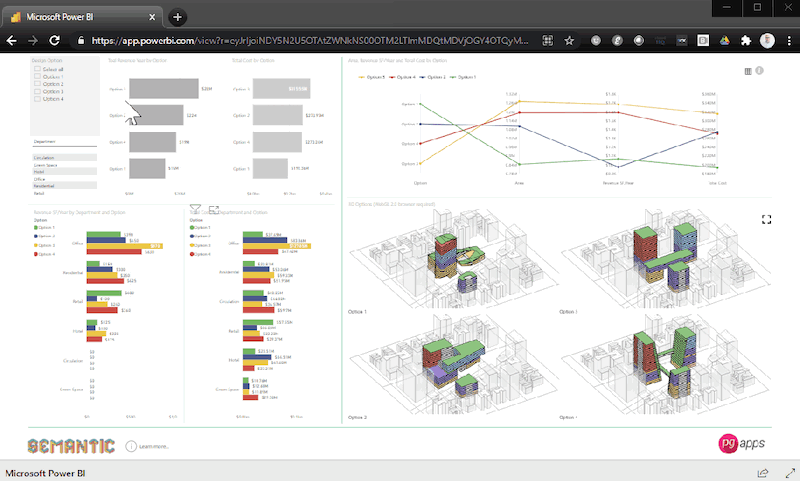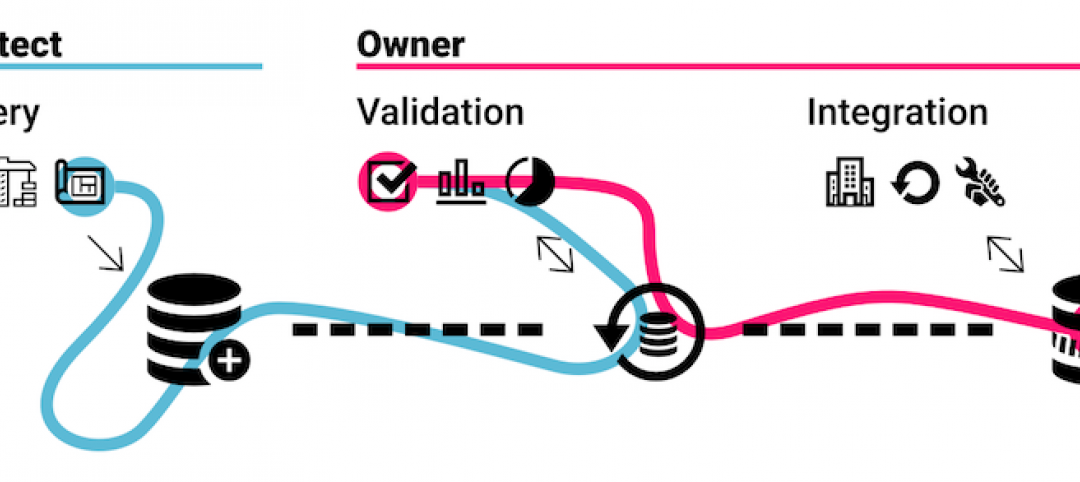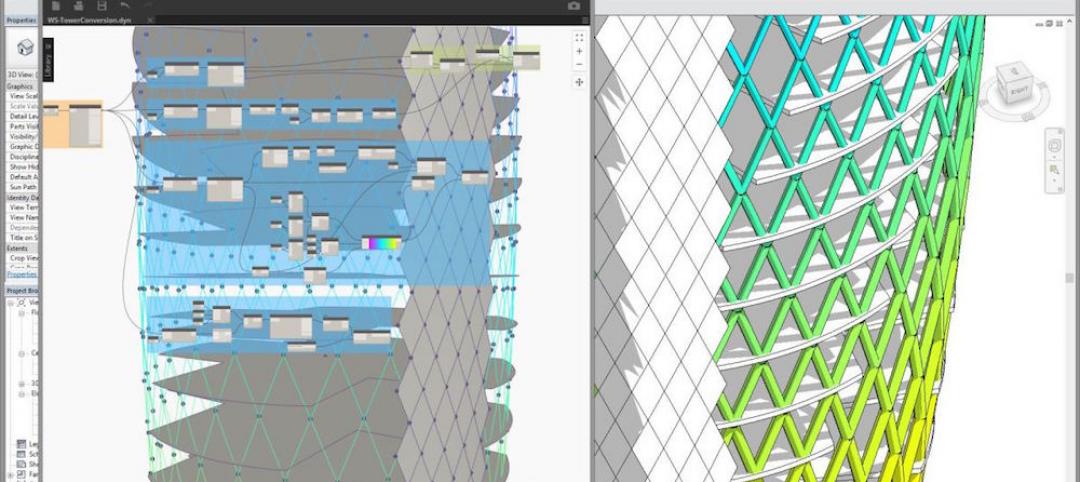Business Intelligence refers to technologies that enable the analysis, reporting, and presentation of data. When Proving Ground first opened our doors almost 6 years ago, it was rare to hear about business intelligence (‘BI’ for short) being implemented as a core component of an AECO organization’s digital strategy. If BI tools – like Power BI or Tableau – were being used within a business, they were most often relegated to accounting departments or among the early-adopters within design technology teams. At the time, the use of BI among a large body of designers, managers, and executives was virtually nonexistent.
In recent years, this has changed dramatically: As designers and builders have accelerated their use of data, the use of BI among a broader contingent AECO stakeholders has become far more pronounced – even integral – to many digital processes.
This article will explore some of the drivers for how BI is finding successful adoption among architects, engineers, contractors, and owners. In our observation, BI adoption is largely being driven by 5 factors:
1. Connecting Multiple Data Sources Together
Building design and construction data is often contained within multiple disparate data sources that do not interact. If you are working on a project today, it is likely the case that data related to a project’s digital models, project management systems, finances, and operations exist fragmented across several databases – and perhaps even across several organizations. Obviously, this can make creating a singular picture of building or business data challenging to achieve.
BI creates an opportunity to connect and correlate many sources of data into a single reporting interface. The advantages likely creates the most compelling driver for BI adoption: by using a flexible interface designed to bring data together, AECO stakeholders can create a more complete picture of their building data and correlate that data among other related sources of information. (For more ideas for how AECO professionals can take advantage of data they already have, give this blog article by Steve Sanda a read!)
2. ‘No Code’ and a Low Barrier to Entry
Business intelligence interfaces today appeal to a larger user base and possess an ever lowering barrier to entry. Historically, this is what made Excel so popular: the technology took a concept that was previously reserved for a narrow group of data experts and made it accessible for the masses (today Excel is estimated to have over 750 million users).
We can observe that BI is following a similar trajectory. Today, users of BI are able to connect to multiple sources of data, create beautiful interactive reports, and share dashboards to the web without needing to write a single line of code or HTML.
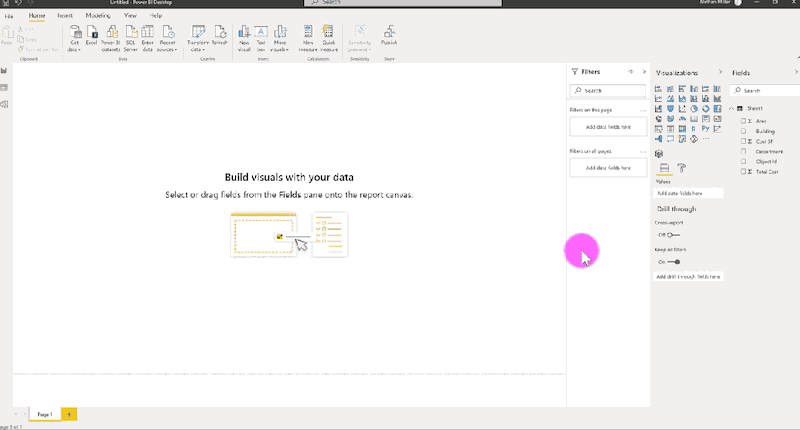
When we look at the construction industry, the low barrier to entry for non-programmers to leverage data in support of design, construction, and operations of buildings makes BI extremely appealing. While developing coding has become a popular premise, the reality is that these skills are still extremely specialized – the concept of ‘no code’ data manipulation makes BI extremely accessible for a broad group of stakeholders.
3. Ease of Procurement and Implementation
Part of the growing popularity of business intelligence stems from availability of options for affordably procuring and implementing the tools. For example, Microsoft Power BI has made a robust BI solution extremely easy to procure for professionals already using the Microsoft Office suite – currently this amounts to a surface area of over a million companies worldwide.
Additionally, the pricing of Power BI makes the technology easy to justify as an investment. Power BI has a free version with tiered subscription models for professional and enterprise reporting.
Because of this, we now see tools like Power BI situated on an industry professional’s desktop alongside common industry tools like Revit, AutoCAD, and Rhino. The ease of procurement is impacting a large pool of users that span organizational hierarchies. Project managers can use BI to understand staff, cost and schedules of a project. Designers can use BI to present design options and alternatives. Executives can use BI to understand the factors and trends impacting their business performance.
4. The Client Demand for Data
Perhaps the single most important driver for the adoption of business intelligence tools is the increasing demand by building owners and clients for insightful data. Designing, constructing, and operating a building is an expensive venture. When an investment in a new facility is being made, owners and clients want to be sure the data is there to support decision making in the near- and long-term.
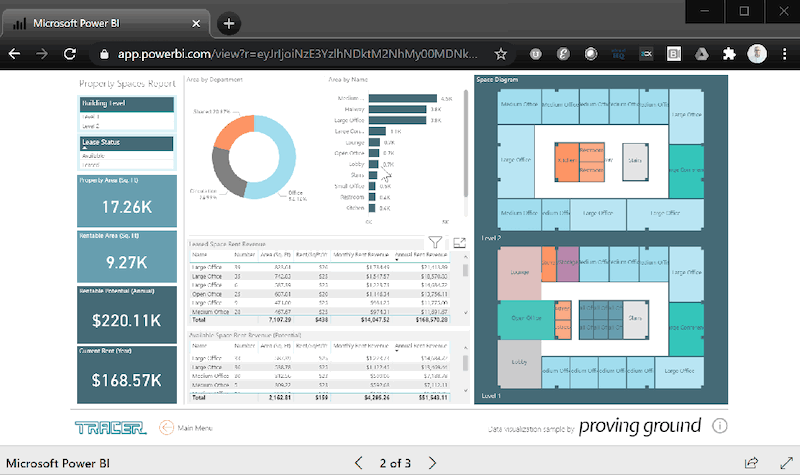
BI can be a powerful capability that provides insight into the data and metrics that drive a construction project’s success and build trust in the process. During design stages, we have seen architects prepare and deliver BI reports that compare key metrics between design alternatives. During construction, contractors are using BI to integrate data about project schedules, labor, and cost. We are also seeing owners, themselves, use BI as a way to understand data about their facilities – including financial, maintenance, and performance metrics over the building lifecycle.
5. Growing Availability of BI Tools for Designers and Builders
While BI platforms provide robust and generalized toolkits for visualizing data, the architectural design and construction world has its own forms of data that benefit from visualization methods supporting 2D and 3D geometry. For example, it is important for a BI report about ‘building area’ requirements to also include visual information about the space plan. In the context of Building Information Modeling, a report about element quantities may be best supported by 3D visualizations depicting building components such as walls, doors, floors, and equipment.
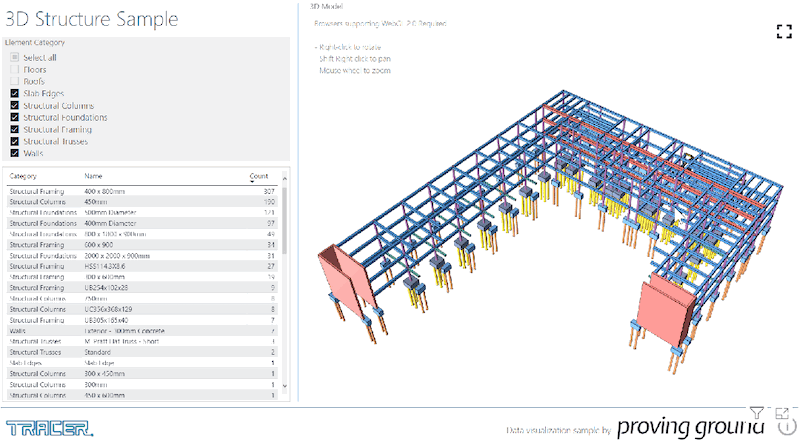
At Proving Ground, we are creating publicly available visualization products for Power BI that situate 2D and 3D geometry alongside conventional visuals such as tables, bar charts, and line graphs. This approach allows industry professionals to create share reports with digital representations of the building authored in popular modeling tools including Revit and Rhino. Additionally, our approach in creating relevant BI tools for the AECO industry aims at addressing widespread need for data by experts and non-experts.
We are currently offering two tools that connect Power BI to popular 3D modeling tools:
- Tracer is a Revit toolkit that allows professionals to export Revit element data to an open database format that can connect directly to Power BI. Our visualization tools provide the ability to drag-and-drop geometric data and compose 2D and 3D reports that can be presented and shared with collaborators.
- Semantic is a Rhino toolkit that allows professionals to integrate data with their Rhino model and connect their models to a Power BI report. Rhino users can compose 3D interactive reports and view their designs on the web.
We see the popularity of business intelligence growing significantly in the coming year as industry professionals continue to find needs and use cases for building data to drive performance in their work. As digital design experts, we are actively working to support this trend with new tools and services to accelerate meaningful adoption of these tools in support of a better built environment.
More from Author
Proving Ground | Oct 8, 2020
4 challenges of realizing BIM's value for an owner
In recent years, we have found our consulting practice engaging more and more with owners that are questioning the value of BIM and how they can make use of potentially data-rich BIM assets.
Proving Ground | Mar 24, 2019
5 ways designers and builders can use business intelligence with data they already have
Tricky construction budgets, large project teams, and unique designs needing extensive coordination are all problems increasingly being handled with new software tools and data.
Proving Ground | Aug 21, 2018
Five habits that are keeping your digital strategy from working
Strategies are always created with the best of intentions for improving business, the effort involved in executing the strategy – especially ones involving disruptive digital capabilities – is greatly underestimated.
Proving Ground | Dec 12, 2017
Reflecting on the future of work
'I believe in the potential for new technology to positively impact the quality of the built environment with immense speed and great efficiency,' writes Proving Ground's Nathan Miller.
Proving Ground | Oct 6, 2017
How professional bias can sabotage industry transformation
Professional bias can take the form of change-resistant thinking that can keep transformational or innovative ambitions at bay. Tech consultant Nate Miller presents three kinds of bias that often emerge when a professional is confronted with new technology.
Proving Ground | May 24, 2017
Data literacy: Your data-driven advantage starts with your people
All too often, the narrative of what it takes to be ‘data-driven’ focuses on methods for collecting, synthesizing, and visualizing data.
Proving Ground | Feb 16, 2017
Positioning computational designers in your business: 4 things to consider
There appears to be very little industry consensus as to what a ‘computational design’ position actually means in a business setting.
Proving Ground | May 9, 2016
3 things to consider for computation in the business of design
In creating a roadmap for computation, Proving Ground's Nathan Miller likes to consider investing in the right people, incorporating a range of skillsets, and defining the business value.
Proving Ground | Apr 15, 2016
Should architects learn to code?
Even if learning to code does not personally interest you, the growing demand for having these capabilities in an architectural business cannot be overlooked, writes computational design expert Nathan Miller.

